Characterization and Modelling of Environmental Crime: A Case Study Applied to the Canary Islands (Spain)
Abstract
1. Introduction
2. Study Area
3. Methodology
3.1. Geographical Database
3.2. Predictive Modelling
4. Results
4.1. Predictive Models Validation
4.2. Areas Potentially Affected by Environmental Crimes
4.3. An Integrated Index for the Canary Islands
5. Discussion
5.1. Spatial Distribution and Human Pressures
5.2. Predictive Modelling as a Methodological Approach
5.3. Limitations and Future Directions
6. Conclusions
- Identifying the spatial patterns of environmental crimes across the Canary Islands, highlighting their concentration in coastal and touristic areas.
- Demonstrating the effectiveness of Random Forest-based models (RF, RRF, FS10) for spatial prediction and explanatory analysis of environmental crime potential.
- Quantifying the territorial extent of environmental crime risk, with around 43% of the archipelago potentially affected by one or more crime types.
- Providing a transferable methodological framework to strengthen environmental governance, surveillance, and preventive planning in island and coastal regions.
Supplementary Materials
Author Contributions
Funding
Data Availability Statement
Conflicts of Interest
References
- Clifford, M.; Edwards, T.D. Defining ‘Environmental Crime’. In Environmental Crime: Enforcement, Policy, and Social; Clifford, M., Ed.; Jones & Bartlett Learning: Burlington, MA, USA, 1998. [Google Scholar]
- Connealy, N.T. The influence, saliency, and consistency of environmental crime predictors: A probability score matching approach to test what makes a hot spot hot. Justice Q. 2023, 40, 670–693. [Google Scholar] [CrossRef]
- Winter, N.L. Mapping environmental crime. In Proceedings of the 20th International Cartographic Conference, Mapping the 21st Century, Beijing, China, 6–10 August 2001; Volume 1, pp. 392–395. [Google Scholar]
- Shover, N.; Routhe, A.S. Environmental crime. Crime Justice 2005, 32, 321–371. [Google Scholar] [CrossRef]
- Fuller, R.; Landrigan, P.J.; Balakrishnan, K.; Bathan, G.; Bose-O′Reilly, S.; Brauer, M.; Caravanos, J.; Chiles, T.; Cohen, A.; Corra, L.; et al. Pollution and health: A progress update. Lancet Planet Health 2022, 6, e535–e547. [Google Scholar] [CrossRef] [PubMed]
- Guo, Q.F.; Hu, M.; Guo, S.; Wu, Z.J.; Hu, W.W.; Peng, J.F.; Hu, W.; Wu, Y.S.; Yuan, B.; Zhang, Q.; et al. The identification of source regions of black carbon at a receptor site off the eastern coast of China. Atmos. Environ. 2015, 100, 78–84. [Google Scholar] [CrossRef]
- Hoogesteger, J.; Wester, P. Intensive groundwater use and (in)equity: Processes and governance challenges. Environ. Sci. Policy 2015, 51, 117–124. [Google Scholar] [CrossRef]
- Cardinale, B.J.; Duffy, J.E.; Gonzalez, A.; Hooper, D.U.; Perrings, C.; Venail, P.; Narwani, A.; Mace, G.M.; Tilman, D.; Wardle, D.A.; et al. Biodiversity loss and its impact on humanity. Nature 2012, 486, 59–67. [Google Scholar] [CrossRef]
- Watson, J.E.M.; Evans, T.; Venter, O.; Williams, B.; Tulloch, A.; Stewart, C.; Thompson, I.; Ray, J.C.; Murray, K.; Salazar, A.; et al. The exceptional value of intact forest ecosystems. Nat. Ecol. Evol. 2018, 2, 599–610. [Google Scholar] [CrossRef]
- McKinney, M.L. Urbanization as a major cause of biotic homogenization. Biol. Conserv. 2006, 127, 247–260. [Google Scholar] [CrossRef]
- Marzouk, M.; Azab, S. Environmental and economic impact assessment of construction and demolition waste disposal using system dynamics. Resour. Conserv. Recycl. 2014, 82, 41–49. [Google Scholar] [CrossRef]
- Bueno, M.V.; Campos, A.D.S.; Silva, J.T.; Massey, J.; Timm, L.C.; Faria, L.C.; Roel, A.; Parfitt, J.M.B. Improving the drainage and irrigation efficiency of lowland soils: Land-forming options for southern Brazil. J. Irrig. Drain. Eng. 2020, 146, 04020019. [Google Scholar] [CrossRef]
- Quesada-Ruiz, L.C.; Rodriguez-Galiano, V.; Jordá-Borrell, R. Characterization and mapping of illegal landfill potential occurrence in the Canary Islands. Waste Manag. 2019, 85, 506–518. [Google Scholar] [CrossRef] [PubMed]
- Reinold, S.; Herrera, A.; Saliu, F.; Hernández-González, C.; Martinez, I.; Lasagni, M.; Gómez, M. Evidence of microplastic ingestion by cultured European sea bass (Dicentrarchus labrax). Mar. Pollut. Bull. 2021, 168, 112450. [Google Scholar] [CrossRef] [PubMed]
- Cunha, I.; Freitas, L.; Alves, F.; Dinis, A.; Ribeiro, C.; Nicolau, C.; Ferreira, R.; Gonçalves, J.A.; Formigo, N. Marine traffic and potential impacts towards cetaceans within the Madeira EEZ. J. Cetacean Res. Manag. 2017, 16, 17–28. [Google Scholar] [CrossRef]
- Shen, M.; Huang, W.; Chen, M.; Song, B.; Zeng, G.; Zhang, Y. (Micro) plastic crisis: Un-ignorable contribution to global greenhouse gas emissions and climate change. J. Clean. Prod. 2020, 254, 120138. [Google Scholar] [CrossRef]
- Verma, S.; Jayakumar, S. Impact of forest fire on physical, chemical and biological properties of soil: A review. Proc. Int. Acad. Ecol. Environ. Sci. 2012, 2, 168. [Google Scholar]
- Mukhlis, I.; Rizaludin, M.S.; Hidayah, I. Understanding socio-economic and environmental impacts of agroforestry on rural communities. Forests 2022, 13, 556. [Google Scholar] [CrossRef]
- White, R. Environmental Crime in Global Context: Exploring the Theoretical and Empirical Complexities. Curr. Issues Crim. Justice 2005, 16, 271–285. [Google Scholar] [CrossRef]
- Goodchild, M.F.; Anselin, L.; Appelbaum, R.P.; Harthorn, B.H. Toward spatially integrated social science. Int. Reg. Sci. Rev. 2000, 23, 139–159. [Google Scholar] [CrossRef]
- Eck, J.E. Policing & Crime Event Concentration. In The Process and Structure of Crime: Criminal Events and Crime Analysis (Chapter 11); Meier, R., Kennedy, L., Sacco, V.F., Eds.; Transaction Publisher: Piscataway, NJ, USA, 2001. [Google Scholar]
- Johnson, S.D.; Bowers, K.J.; Birks, D.J.; Pease, K. Predictive Mapping of Crime by ProMap: Accuracy, Units of Analysis, and the Environmental Backcloth. In Putting Crime in Its Place; Weisburd, D., Ed.; Springer Science+Business Media, LLC: Berlin/Heidelberg, Germany, 2009; p. 171. [Google Scholar] [CrossRef]
- Quesada-Ruiz, L.C.; Perez, L.; Rodriguez-Galiano, V. Spatiotemporal analysis of the housing bubble’s contribution to the proliferation of illegal landfills—The case of Gran Canaria. Sci. Total Environ. 2019, 687, 104–117. [Google Scholar] [CrossRef]
- Fereira Rosa, A.G.; Miranda Mota, C.M.; Jardim de Figuereido, C.J. A spatial multi-criteria decision analysis framework to reveal vulnerabilities of areas to incidences of street robberies. Appl. Geogr. 2023, 151, 102840. [Google Scholar] [CrossRef]
- Kubalova, K.; Loveček, T. Crime prevention through environmental design of railway stations as a specific soft target. Sustainability 2023, 15, 5627. [Google Scholar] [CrossRef]
- Saraiva, M.; Teixeira, B. Exploring the spatial relationship between street crime events and the distribution of urban greenspace: The case of Porto, Portugal. ISPRS Int. J. Geo-Inf. 2023, 12, 492. [Google Scholar] [CrossRef]
- Rosser, G.; Davies, T.; Bowers, K.J.; Johnson, S.D.; Cheng, T. Predictive Crime Mapping: Arbitrary Grids or Street Networks? J. Quant. Criminol. 2017, 33, 569–594. [Google Scholar] [CrossRef]
- Breiman, L. Random forests. Mach. Learn. 2001, 45, 5–32. [Google Scholar] [CrossRef]
- Rodriguez-Galiano, V.F.; Chica-Rivas, M. Evaluation of different machine learning methods for land cover mapping of a Mediterranean area using multi-seasonal Landsat images and Digital Terrain Models. Int. J. Digit. Earth 2012, 7, 492–509. [Google Scholar] [CrossRef]
- Izquierdo-Verdiguier, E.; Zurita-Milla, R. Use of guided regularized random forest for biophysical parameter retrieval. In Proceedings of the IGARSS 2018—2018 IEEE International Geoscience and Remote Sensing Symposium, Valencia, Spain, 22–27 July 2018; pp. 5776–5779. [Google Scholar]
- Quesada-Ruiz, L.C.; Rodriguez-Galiano, V.F.; Zurita-Milla, R.; Izquierdo-Verdiguier, E. Area and Feature Guided Regularised Random Forest: A novel method for predictive modelling of binary phenomena. The case of illegal landfill in Canary Island. Int. J. Geogr. Inf. Sci. 2022, 36, 2473–2495. [Google Scholar] [CrossRef]
- Li, F.; Qi, D.; He, Y. Analysis of the decoupling relationship between environmental pollution and economic development in island areas: A case study of Zhoushan Islands, China. Sustainability 2024, 16, 5567. [Google Scholar] [CrossRef]
- Joshi, N.; Shaikh, S.; Tripathy, A.; Sen, S.; Janson, J.; Karnik, S.; Varghese, B. Crime anatomization using QGIS. In Proceedings of the 2019 5th International Conference for Convergence in Technology (I2CT), Pune, India, 29–31 March 2019. [Google Scholar] [CrossRef]
- Tasaki, T.; Matsui, Y.; Kawahata, T.; Osako, M.; Takagishi, S.; Morita, A. Analysis of geographic attributes and probabilities related to illegal dumping. J. Jpn. Soc. Waste Manag. Experts 2004, 15, 1–10. [Google Scholar] [CrossRef]
- Cohen, L.E.; Felson, M. Social change and crime rate trends: A routine activity approach. Am. Sociol. Rev. 1979, 44, 588–608. [Google Scholar] [CrossRef]
- Brantingham, P.L.; Brantingham, P.J. Environment, routine, and situation: Toward a pattern theory of crime. In Routine Activity and Rational Choice: Advances in Criminological Theory; Clarke, R.V., Felson, M., Eds.; Transaction Publishers: Piscataway, NJ, USA, 1993; Volume 5, pp. 259–294. [Google Scholar]
- Ceccato, V. Environmental criminology in crime prevention: Theories for practice. Secur. J. 2024, 37, 425–431. [Google Scholar] [CrossRef]
- Suprayogi, B.S.; Nugroho, S.; Fitriana, A.S.; Pratiwi, F.I. Mapping the landscape of environmental crime: A literature review. Environ. Adv. 2025, 12, 100246. [Google Scholar] [CrossRef]
- Troll, V.; Carracedo, J.C. The Canary Islands: An Introduction. In The Geology of the Canary Islands; Elsevier: Amsterdam, The Netherlands, 2016. [Google Scholar] [CrossRef]
- Government of the Canary Islands (n.d.). Canary Islands Natural Inventory Bank (BIOCAN). Available online: https://www.biodiversidadcanarias.es/ (accessed on 20 July 2025).
- MAPAMA. Memoria de la Red de Parques Nacionales; Ministerio de Agricultura, Pesca, Alimentación y Medio Ambiente del Gobierno de España: Madrid, Spain, 2015.
- INE. Movimientos Turísticos en Fronteras. Frontur; Instituto Nacional de Estadística: Madrid, Spain, 2020. Available online: https://www.ine.es/dyngs/Prensa/FRONTUR0725.htm (accessed on 7 January 2025).
- Domínguez Mújica, J.; Moreno Medina, C.; Ginés de la Nuez, C. Agricultura y paisaje en Canarias. In La Perspectiva de Francisco María de León y Falcón; Anroart Ediciones, Las Palmas de Gran Canaria: Las Palmas, Spain, 2005; ISBN 978-84934211-0-6. [Google Scholar]
- INE. Estadística del Padron Continuo; Instituto Nacional de Estadística: Madrid, Spain, 2020a. Available online: http://www.ine.es/dyngs/INEbase/es/categoria.htm?c=Estadistica_P&cid=1254734710990 (accessed on 7 January 2025).
- Hernández Martín, R.; Santana Talavera, A. Destinos turísticos maduros ante el cambio. In Reflexiones Desde Canarias; Universidad de La Laguna: Santa Cruz de Tenerife, Spain, 2010; ISBN 978-84-614-3386-5. [Google Scholar]
- Ferrer, N.; Herrera, G. High-resolution modelling of island exposure to natural hazards tested with real disasters. Appl. Geogr. 2024, 165, 103239. [Google Scholar] [CrossRef]
- Carranza, E.J.M.; Hale, M.; Faassen, C. Selection of coherent deposit-type locations and their application in data-driven mineral prospectivity mapping. Ore Geol. Rev. 2008, 33, 536–558. [Google Scholar] [CrossRef]
- Quesada-Ruiz, L.C.; García-Romero, L.; Ferrer-Valero, N. Mapping environmental crime to characterize human impacts on islands: An applied and methodological research in Canary Islands. J. Environ. Manag. 2023, 346, 118959. [Google Scholar] [CrossRef]
- Tuv, E. Feature selection with ensembles. Artif. Var. Redundancy Elimin. 2009, 10, 1341–1366. [Google Scholar]
- Rodriguez-Galiano, V.F.; Luque-Espinar, J.A.; Chica-Olmo, M.; Mendes, M.P. Feature selection approaches for predictive modelling of groundwater nitrate pollution: An evaluation of filters, embedded and wrapper methods. Sci. Total Environ. 2018, 624, 661–672. [Google Scholar] [CrossRef]
- Deng, H.; Runger, G. Gene selection with guided regularized random forest. Pattern Recognit. 2013, 46, 3483–3489. [Google Scholar] [CrossRef]
- Rodriguez-Galiano, V.; Mendes, M.P.; Garcia-Soldado, M.J.; Chica-Olmo, M.; Ribeiro, L. Predictive modeling of groundwater nitrate pollution using Random Forest and multisource variables related to intrinsic and specific vulnerability: A case study in an agricultural setting (Southern Spain). Sci. Total Environ. 2014, 476, 189–206. [Google Scholar] [CrossRef]
- Chen, L. Curse of dimensionality. In Encyclopedia of Database Systems; Liu, E.L., Özsu, M.T., Eds.; Springer: New York, NY, USA, 2009. [Google Scholar]
- Blum, A.L.; Langley, P. Selection of relevant features and examples in machine learning. Artif. Intell. 1997, 97, 245–271. [Google Scholar] [CrossRef]
- Dash, M.; Liu, H. Feature selection for classification. Intell. Data Anal. 1997, 1, 131–156. [Google Scholar] [CrossRef]
- Guyon, I.; Elisseeff, A. An introduction to variable and feature selection. J. Mach. Learn. Res. 2003, 3, 1157–1182. [Google Scholar]
- Amat, S. MLR: Machine Learning in R. R Package Version 1.0. 2010. Available online: https://cran.r-project.org/web/packages/mlr/index.html (accessed on 7 January 2025).
- Observatorio Turístico de Canarias. Sostenibilidad del Turismo en Canarias. Informe 2023; Observatorio Turístico de Canarias: Las Palmas de Gran Canaria, Spain, 2023.
- Monterroso Hoyos, O.; Rodríguez, M.; Ramos, E.; Álvarez, O. Estudios ambientales en relación con los vertidos de tierra al mar en Canarias. In Agua: Reflexiones para Una Gestión Eficaz; Instituto de Estudios Hispánicos de Canarias: Santa Cruz de Tenerife, Spain, 2019; pp. 109–118. [Google Scholar]
- Gobierno de España. Ley 4/2017, de 13 de Julio, del Suelo y de los Espacios Naturales Protegidos de Canarias. Boletín Oficial del Estado, nº 138, 71167–71331. Available online: https://www.boe.es/buscar/act.php?id=BOE-A-2017-10295 (accessed on 13 July 2017).
- An, R.; Liu, P. Research on the environmental philosophy of China’s environmental crime legislation from the perspective of ecological civilization construction. Int. J. Environ. Res. Public Health 2023, 20, 1517. [Google Scholar] [CrossRef]
- Odoardi, I.; D’Ingiullo, D.; Di Nucci, A.; Quaglione, D. Exploring the influence of crime on NEET rates: A regional analysis of Italy. Merits 2024, 4, 132–145. [Google Scholar] [CrossRef]
- Caplan, J.M.; Kennedy, L.W.; Drawve, G.; Baughman, J.H. Data-Informed and Place-Based Violent Crime Prevention: The Kansas City, Missouri Risk-Based Policing Initiative. Police Q. 2021, 24, 438–464. [Google Scholar] [CrossRef]
- Pal, M.; Foody, G.M. Feature selection for classification of hyperspectral data by SVM. IEEE Trans. Geosci. Remote Sens. 2010, 48, 2297–2307. [Google Scholar] [CrossRef]
- Sesnie, S.E.; Gessler, P.E.; Finegan, B.; Thessler, S. Integrating Landsat TM and SRTM-DEM derived variables with decision trees for habitat classification and change detection in complex neotropical environments. Remote Sens. Environ. 2008, 112, 2145–2159. [Google Scholar] [CrossRef]
- Arabameri, A.; Rezaei, K.; Cerda, A.; Lombardo, L.; Rodrigo-Comino, J. Science of the total environment GIS-based groundwater potential mapping in Shahroud plain, Iran. A comparison among statistical (bivariate and multivariate), data mining and MCDM approaches. Sci. Total Environ. 2019, 658, 160–177. [Google Scholar] [CrossRef]
- Rahmati, O.; Reza Hy Melesse, A.M. Catena Application of GIS-based data driven random forest and maximum entropy models for groundwater potential mapping: A case study at Mehran Region, Iran. Catena 2016, 137, 360–372. [Google Scholar] [CrossRef]
- Izquierdo-Verdiguier, E.; Zurita-Milla, R. An evaluation of Guided Regularized Random Forest for classification and regression tasks in remote sensing. Int. J. Appl. Earth Obs. Geoinf. 2020, 88, 102051. [Google Scholar] [CrossRef]
- Piquero, A.R.; Weisburd, D. Handbook of Quantitative Criminology; Piquero, A.R., Weisburd, D., Eds.; Springer Science+Business Media, LLC: New York, NY, USA, 2010. [Google Scholar] [CrossRef]
- Hall, P.A.; McKirdy, D.M.; Grice, K.; Edwards, D.S. Australasian asphaltite strandings: Their origin reviewed in light of the effects of weathering and biodegradation on their biomarker and isotopic profiles. Mar. Pet. Geol. 2014, 57, 572–593. [Google Scholar] [CrossRef]
- Polvi, N.; Looman, T.; Humphries, C.; Pease, K. The time course of repeat burglary victimisation. Br. J. Criminol. 1991, 31, 411–414. [Google Scholar] [CrossRef]

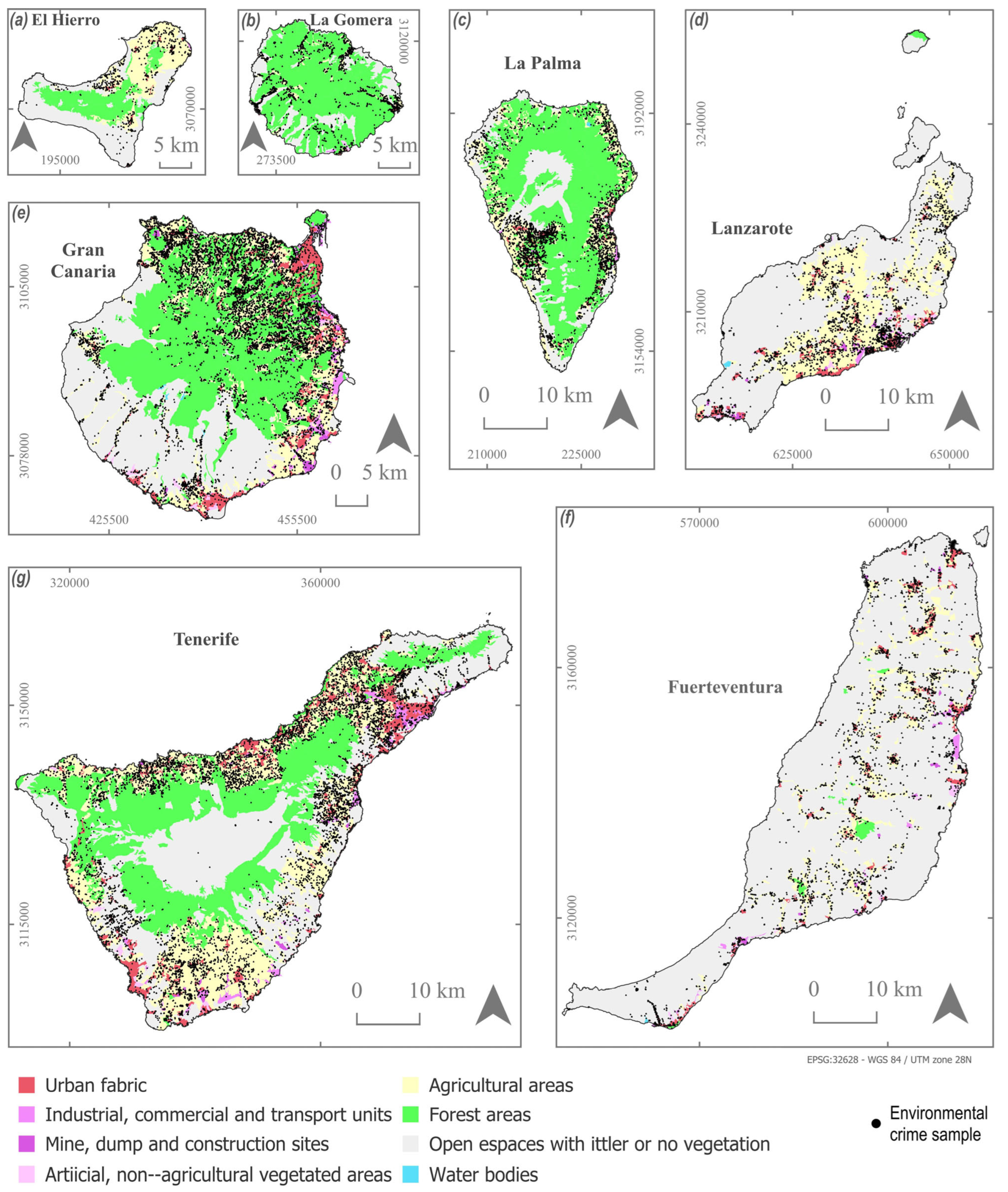

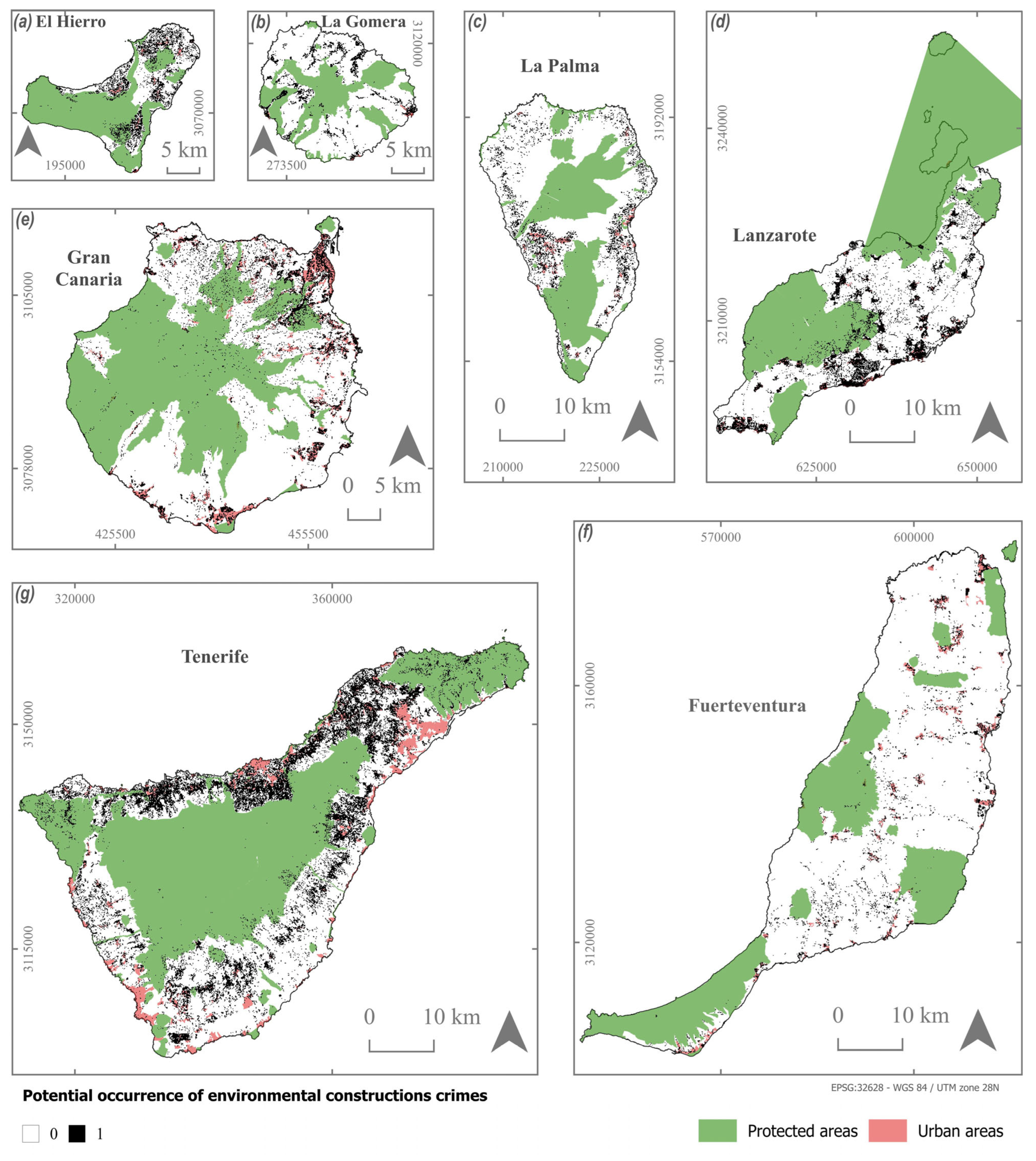
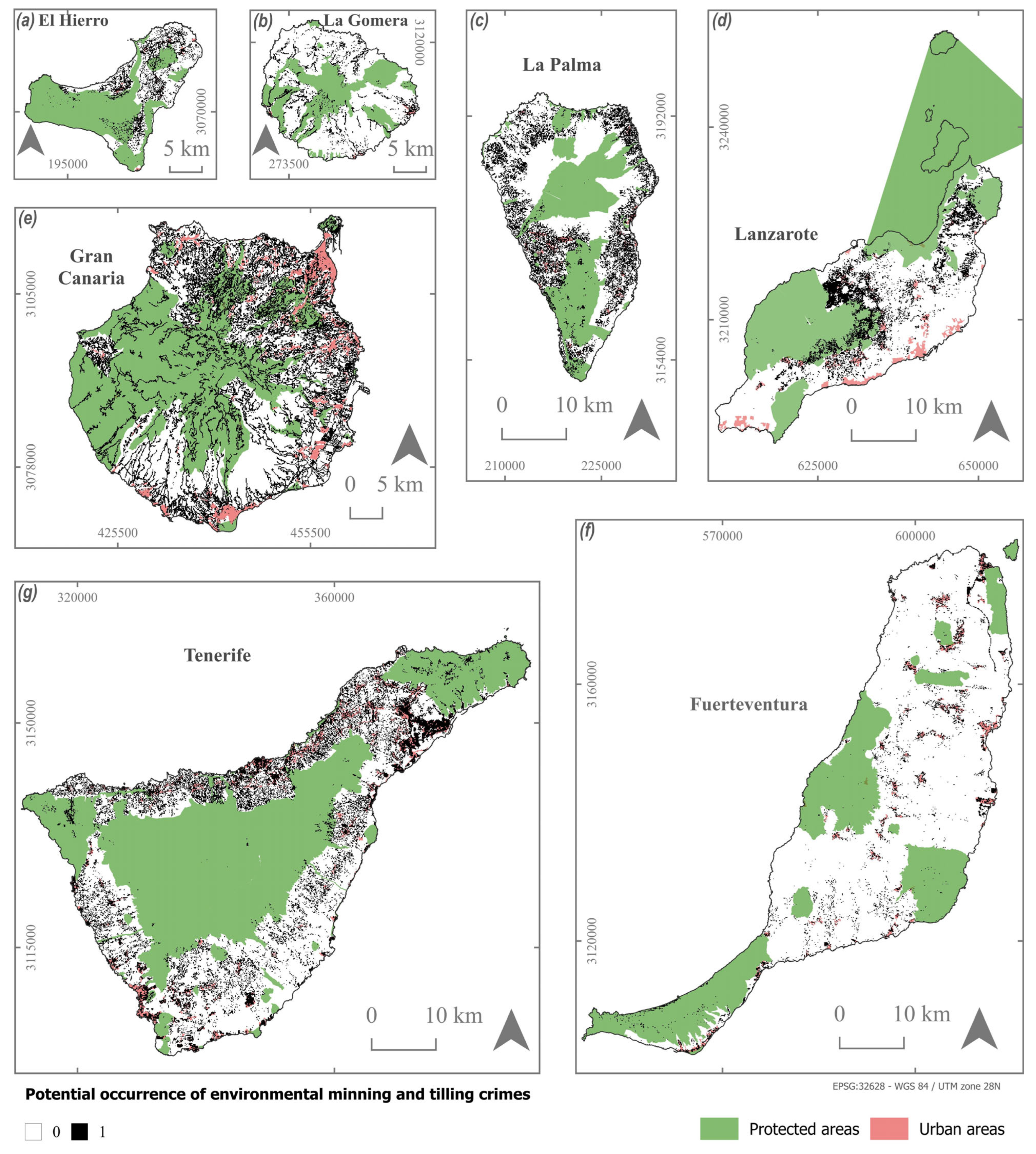

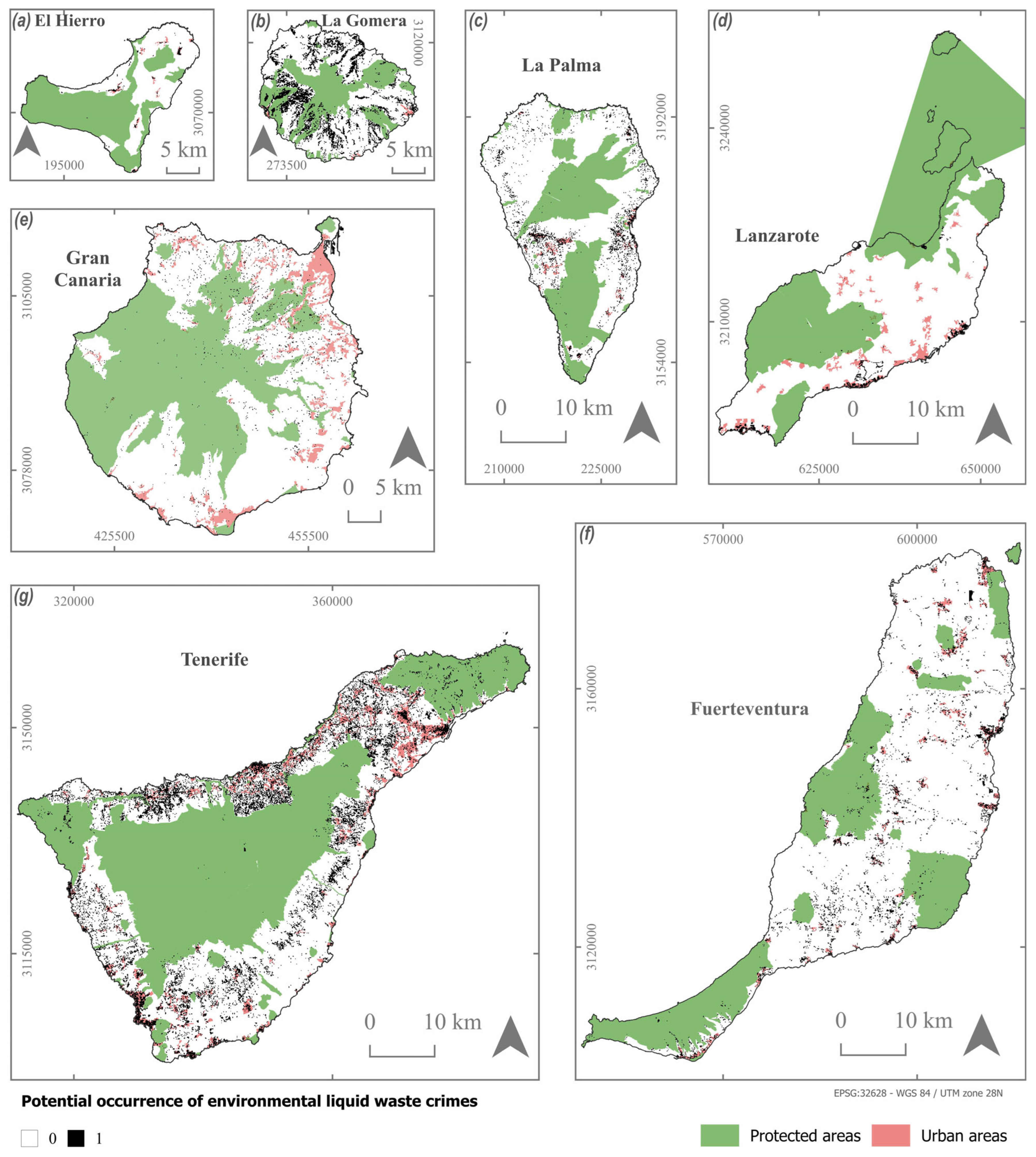
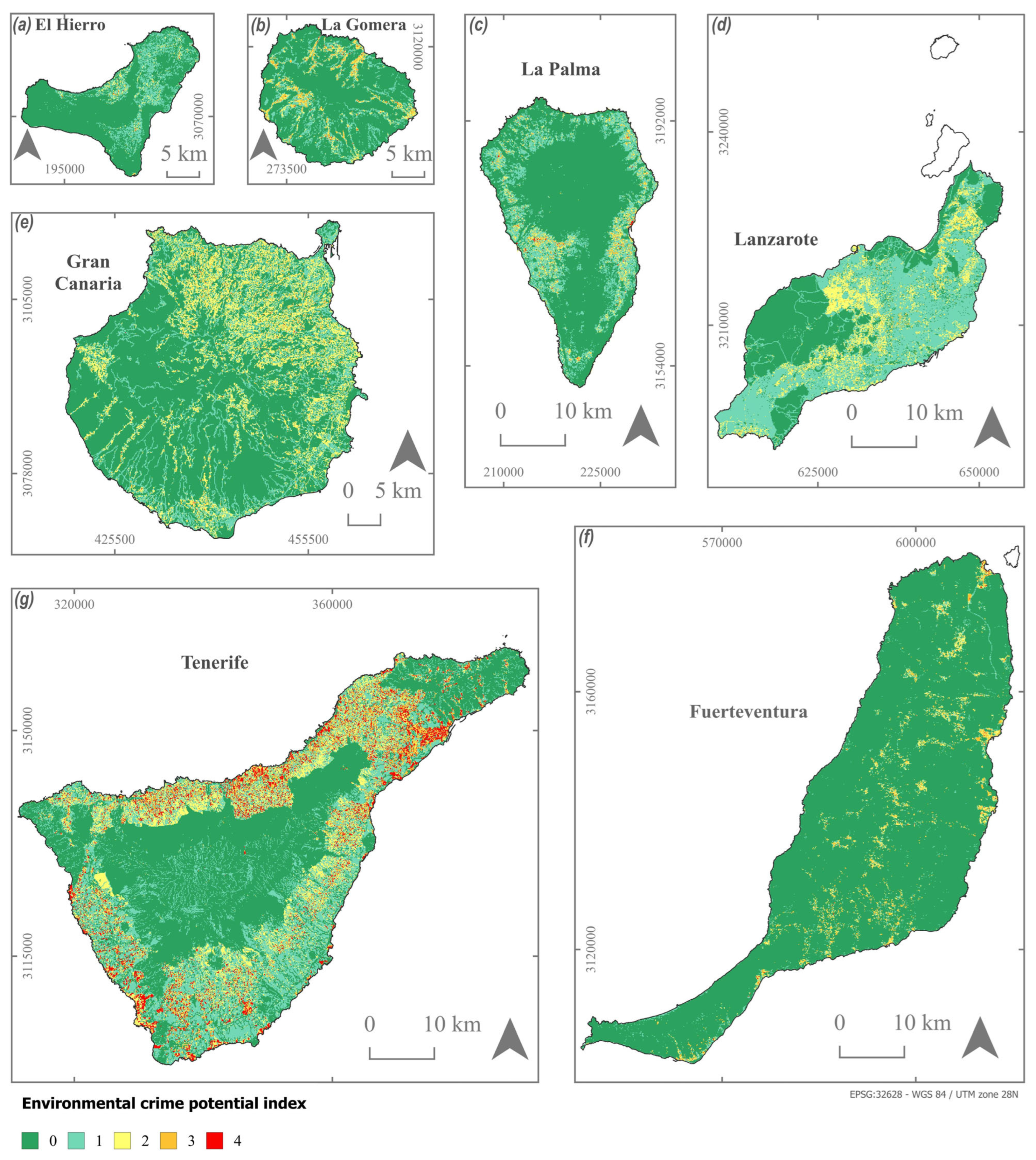
| Category | Examples of Features | Source(s) |
|---|---|---|
| Environmental crime records | Illegal constructions, solid and liquid waste dumping, mining and tilling | APMUN |
| Land use and services | Crops, residential accommodations, industrial areas, tourist dwellings, services (restaurants, hotels) | GRAFCAN |
| Accessibility | Highways, urban streets, paths, secondary roads | GRAFCAN |
| Physical features | Distance to coast, altitude, slope, protected natural spaces, vegetation index (NDVI) | GRAFCAN; ESA |
| Socio-demography | Population density, age structure, household size, income distribution, unemployment | INE |
| Constructions and Buildings (B) | Mining and Tilling (M) | |||||||||||||||
|---|---|---|---|---|---|---|---|---|---|---|---|---|---|---|---|---|
| RF | RRF | FS10 | RF | RRF | FS10 | |||||||||||
| OA | AUC | OA | NF | AUC | OA | NF | AUC | OA | AUC | OA | NF | AUC | OA | NF | AUC | |
| LZ | 93.9 | 0.9 | 93.9 | 60 | 0.9 | 94.3 | 10 | 0.9 | 85.4 | 0.8 | 86.1 | 36 | 0.7 | 85.4 | 10 | 0.7 |
| FTV | 93.2 | 0.8 | 93.4 | 49 | 0.8 | 93.4 | 10 | 0.9 | 82.4 | 0.8 | 83.3 | 26 | 0.8 | 86.1 | 10 | 0.8 |
| GC | 89.0 | 0.8 | 89.1 | 100 | 0.7 | 88.4 | 10 | 0.8 | 88.1 | 0.8 | 88.5 | 78 | 0.8 | 89.9 | 10 | 0.8 |
| TNF | 92.9 | 0.8 | 92.8 | 101 | 0.8 | 92.2 | 10 | 0.9 | 90.8 | 0.7 | 90.8 | 81 | 0.8 | 89.1 | 10 | 0.8 |
| LG | 96.4 | 0.9 | 97.3 | 12 | 0.9 | 96.7 | 10 | 0.9 | 91.9 | 0.9 | 92.7 | 18 | 0.9 | 91.9 | 10 | 0.9 |
| LP | 94.3 | 0.7 | 94.1 | 64 | 0.7 | 92.6 | 10 | 0.9 | 84.6 | 0.8 | 85.7 | 21 | 0.7 | 83.5 | 10 | 0.8 |
| EH | 95.2 | 0.8 | 97.3 | 19 | 0.8 | 95.2 | 10 | 0.8 | 89.1 | 0.8 | 88.9 | 15 | 0.8 | 92.6 | 10 | 0.8 |
| Solid waste (S) | Liquid waste (L) | |||||||||||||||
| RF | RRF | FS10 | RF | RRF | FS10 | |||||||||||
| OA | AUC | OA | NF | AUC | OA | NF | AUC | OA | AUC | OA | NF | AUC | OA | NF | AUC | |
| LZ | 91.7 | 0.8 | 92.0 | 82 | 0.8 | 91.9 | 10 | 0.8 | 92.9 | 0.9 | 95.7 | 9 | 0.9 | 97.1 | 10 | 0.9 |
| FTV | 93.7 | 0.8 | 93.0 | 55 | 0.8 | 93.2 | 10 | 0.9 | 87.9 | 0.8 | 92.4 | 5 | 0.8 | 89.4 | 10 | 0.8 |
| GC | 92.7 | 0.8 | 92.9 | 101 | 0.8 | 92.6 | 10 | 0.8 | 91.9 | 0.5 | 93.3 | 6 | 0.8 | 92.8 | 6 | 0.5 |
| TNF | 89.0 | 0.8 | 89.3 | 101 | 0.8 | 89.0 | 10 | 0.8 | 96.6 | 0.8 | 97.6 | 22 | 0.8 | 96.9 | 10 | 0.8 |
| LG | 95.1 | 0.8 | 95.3 | 34 | 0.7 | 93.1 | 10 | 0.8 | 88.9 | 0.8 | 88.9 | 10 | 0.8 | 88.9 | 10 | 0.8 |
| LP | 93.7 | 0.7 | 94.1 | 54 | 0.8 | 93.7 | 10 | 0.8 | 83.3 | 0.8 | 83.3 | 7 | 0.8 | 88.9 | 10 | 0.9 |
| EH | 92.7 | 0.8 | 94.5 | 22 | 0.83 | 93.6 | 10 | 0.8 | 100.0 | 0.8 | 75.0 | 1 | 0.7 | 87.5 | 10 | 0.7 |
| B | M | S | L | |||||
|---|---|---|---|---|---|---|---|---|
| km2 | % | km2 | % | km2 | % | km2 | % | |
| LZ | 101.3 | 12.6 | 108.8 | 13.6 | 424.4 | 53.0 | 19.6 | 2.5 |
| FTV | 52.8 | 3.2 | 64.8 | 3.9 | 58.8 | 3.5 | 57.4 | 3.5 |
| GC | 109.0 | 7.0 | 412.8 | 26.4 | 337.7 | 21.6 | 35.6 | 2.3 |
| TNF | 431.8 | 21.2 | 305.6 | 15.0 | 792.5 | 38.9 | 276.1 | 13.6 |
| LG | 23.9 | 6.5 | 10.1 | 2.7 | 50.3 | 13.7 | 59.53 | 16.1 |
| LP | 49.7 | 7.0 | 149.1 | 21.0 | 39.2 | 5.5 | 41.2 | 5.8 |
| EH | 42.1 | 15.7 | 22.5 | 8.3 | 10.2 | 3.8 | 2.2 | 0.8 |
| 0 | 1 | 2 | 3 | 4 | (1–4 Inclusive) | |||||||
|---|---|---|---|---|---|---|---|---|---|---|---|---|
| km2 | % | km2 | % | km2 | % | km2 | % | km2 | % | km2 | % | |
| LZ | 337.7 | 39.9 | 387.3 | 48.4 | 107.2 | 13.4 | 13.6 | 1.7 | 0.0 | 0.0 | 508.2 | 63.4 |
| FTV | 1533.9 | 92.5 | 53.6 | 3.2 | 42.6 | 2.6 | 27.8 | 1.7 | 1.1 | 0.1 | 125.2 | 7.6 |
| GC | 976.1 | 53.7 | 329.46 | 23.0 | 217.87 | 14.1 | 36.2 | 8.4 | 1.36 | 0.8 | 584.9 | 46.3 |
| TNF | 986.5 | 48.5 | 613.3 | 30.1 | 221.5 | 10.9 | 104.4 | 5.1 | 108.6 | 5.3 | 1047.9 | 51.5 |
| LG | 272.6 | 74.1 | 63.12 | 17.1 | 17.1 | 4.6 | 14.27 | 3.9 | 0.91 | 0.25 | 95.41 | 25.9 |
| LP | 497.4 | 70.2 | 160.1 | 22.6 | 34.9 | 4.9 | 14.4 | 2.0 | 1.6 | 0.2 | 210.9 | 29.8 |
| EH | 202.8 | 75.5 | 58.2 | 21.6 | 6.2 | 2.3 | 1.3 | 0.5 | 0.1 | 0.0 | 65.9 | 24.5 |
Disclaimer/Publisher’s Note: The statements, opinions and data contained in all publications are solely those of the individual author(s) and contributor(s) and not of MDPI and/or the editor(s). MDPI and/or the editor(s) disclaim responsibility for any injury to people or property resulting from any ideas, methods, instructions or products referred to in the content. |
© 2025 by the authors. Published by MDPI on behalf of the International Society for Photogrammetry and Remote Sensing. Licensee MDPI, Basel, Switzerland. This article is an open access article distributed under the terms and conditions of the Creative Commons Attribution (CC BY) license (https://creativecommons.org/licenses/by/4.0/).
Share and Cite
Quesada-Ruiz, L.C.; Ferrer-Valero, N.; García-Romero, L. Characterization and Modelling of Environmental Crime: A Case Study Applied to the Canary Islands (Spain). ISPRS Int. J. Geo-Inf. 2025, 14, 410. https://doi.org/10.3390/ijgi14110410
Quesada-Ruiz LC, Ferrer-Valero N, García-Romero L. Characterization and Modelling of Environmental Crime: A Case Study Applied to the Canary Islands (Spain). ISPRS International Journal of Geo-Information. 2025; 14(11):410. https://doi.org/10.3390/ijgi14110410
Chicago/Turabian StyleQuesada-Ruiz, Lorenzo Carlos, Nicolás Ferrer-Valero, and Leví García-Romero. 2025. "Characterization and Modelling of Environmental Crime: A Case Study Applied to the Canary Islands (Spain)" ISPRS International Journal of Geo-Information 14, no. 11: 410. https://doi.org/10.3390/ijgi14110410
APA StyleQuesada-Ruiz, L. C., Ferrer-Valero, N., & García-Romero, L. (2025). Characterization and Modelling of Environmental Crime: A Case Study Applied to the Canary Islands (Spain). ISPRS International Journal of Geo-Information, 14(11), 410. https://doi.org/10.3390/ijgi14110410







